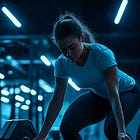Comparing Muscle Forces During Back Squats, Goodmornings, and Split Squats
Analysing the lower-leg muscles during common lifts in women.
This study investigated lower leg muscle forces during strength exercises in females, focusing on back squats, good mornings, and split squats. The research aimed to better understand muscle engagement and its role in injury prevention, particularly for anterior cruciate ligament (ACL) injuries, which are more common in women.
PMID: 38651426
Key Points
8 female participants performed exercises with 25% body weight load (additional 50% for back squats)
Personalised musculoskeletal models, EMG, and motion capture were used to assess muscle groups
Exercises analysed: back squats, good mornings, split squats
Focus on gluteal, quadriceps, and hamstring muscles
Methods
Participants: 8 healthy females (mean age 26.5 ± 3.1 years)
Equipment: VICON motion capture system, force plates, EMG sensors
Exercises: Back squats (25% and 50% body weight), good mornings (25%), split squats (25%)
Analysis: OpenSim musculoskeletal modelling, static optimisation, EMG processing
Related
Results
Quadriceps Muscles:
Highest forces in back squats, especially rectus femoris (>25 N/kg)
High forces in the back leg during split squats (>15 N/kg)
Gluteal Muscles:
Most active during good mornings and front leg of split squats
M. gluteus maximus medial part showed the highest forces (>20 N/kg)
Hamstring Muscles:
Highest forces in the front leg of split squats
M. semimembranosus generated the greatest amount of force
Joint Angles and Moments:
Similar maximum knee flexion angles for front leg and back squats (~120°)
Good mornings: slight knee bend (~40°)
Highest moments in rear leg of split squats (2.21 Nm/kg)











